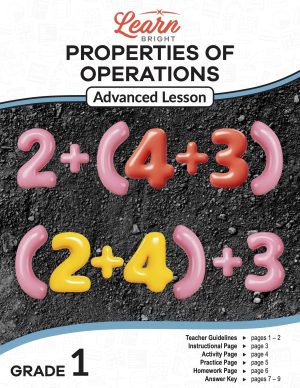Description
What our Equal Sign Meaning lesson plan includes
Lesson Objectives and Overview: Equal Sign Meaning not only defines an equal (=) sign for students but also offers a history of the equals sign and how it came to be the agreed-upon symbol in math. The lesson reminds students that the equals (=) sign is always placed between two (or more) expressions that have the same value. Unlike other math symbols like the plus (+) sign or minus (-) sign, the equal (=) sign does not tell you to do anything, it just gives you information. At the end of the lesson, students will be able to understand the meaning of the equal sign and apply the concept of equality to determine if an addition or subtraction equation is true or false. This lesson is for students in 1st grade and 2nd grade.
Classroom Procedure
Every lesson plan provides you with a classroom procedure page that outlines a step-by-step guide to follow. You do not have to follow the guide exactly. The guide helps you organize the lesson and details when to hand out worksheets. It also lists information in the blue box that you might find useful. You will find the lesson objectives, state standards, and number of class sessions the lesson should take to complete in this area. In addition, it describes the supplies you will need as well as what and how you need to prepare beforehand.
Options for Lesson
Included with this lesson is an “Options for Lesson” section that lists a number of suggestions for activities to add to the lesson or substitutions for the ones already in the lesson. One optional addition to this lesson is to have your students use tiles or disks to create equations and understand that they are balanced. You could also introduce the commutative property of addition. For an additional activity, you could have your students create their own math equations and exchange them with a partner. You could also play a stand up sit down game and see who can solve equations correctly. If you have more advanced students, you can have them begin to place two facts on either side of the equal sign.
Teacher Notes
The teacher notes page includes lines that you can use to add your own notes as you’re preparing for this lesson.
EQUAL SIGN MEANING LESSON PLAN CONTENT PAGES
Equal Sign Meaning
The Equal Sign Meaning lesson plan includes one page of content. Mathematicians use the equal sign to indicate that two things have the same value. However, we did not always have the equal sign! Way back in 1557, a man named Robert Recorde created the symbol while writing a book about math. He was tired of having to write “is equal to” over and over again. He decided that the symbol should have two parallel lines because those two lines are the most equal things in the world. Recorde starting using the symbol in his book.
However, not everyone liked the symbol. Some people used the symbol ‘||’ or wrote ae or oe, which come from old Latin. It took about 200 years for mathematicians to agree to only use the = sign.
We always put the equal sign between two or more expressions with the same value. What’s on one side of the equal sign is the same as what’s on the other side. The equal sign differs from the plus and minus signs in that it doesn’t tell you to do an operation. The plus sign tells you to add and the minus sign tells you to subtract, but the equal sign doesn’t tell you to do anything—just that both sides are equal.
We know that 5 = 5 is true because both sides have the same value. This makes it a true statement. Is 3 = 7 a true statement? No! It’s false, because the two sides are not equal. Some more examples of true statements using equal signs are 6 = 6, 1 = 1, and 12 = 12. Some examples of false statements are 8 = 10, 4 = 9, and 3 = 2.
Equations are mathematical statements with an equal sign between two values. The above examples of true and false statements are all equations. However, equations can also be a little more complex. For example, 4 + 2 = 6 is also an equation. This example is a true statement because both sides have the same value.
Some examples of true equations are 3 + 3 = 6, 1 – 0 = 1, and 10 – 3 = 7. Some examples of false equations are 7 – 2 = 10, 4 + 4 = 9, and 9 + 3 = 10. You can switch the order that your equation is written in and still have a true statement. For example, both 10 + 5 = 15 and 15 = 5 + 10 are true equations!
EQUAL SIGN MEANING LESSON PLAN WORKSHEETS
The Equal Sign Meaning lesson plan includes four worksheets: an activity worksheet, a practice worksheet, a homework assignment, and a quiz. You can refer to the guide on the classroom procedure page to determine when to hand out each worksheet.
CARD MATCHING ACTIVITY WORKSHEET
For the activity worksheet, each student will receive a card with either a whole number or an equation. Once the teacher says “Go,” the students will try to find the card that equals theirs as fast as possible. Once all of the students have found their equal, they will return their cards, shuffle them, and repeat the game!
EQUAL PROBLEMS PRACTICE WORKSHEET
For the practice worksheet, students will look at many problems and circle the ones that are equal.
EQUAL SIGN MEANING HOMEWORK ASSIGNMENT
The homework assignment asks students to design and color in their own equal sign. They will then write two math equations that are true (one addition and one subtraction) and two math equations that are false (one addition and one subtraction).
QUIZ
This lesson also includes a quiz that you can use to test students’ understanding of the lesson material. For the quiz, students will first draw an equal sign. Next, they will look at six equations. If any of them are false, they will place an ‘x’ across the problem.
Worksheet Answer Keys
This lesson plan includes answer keys for the practice worksheet and the quiz. If you choose to administer the lesson pages to your students via PDF, you will need to save a new file that omits these pages. Otherwise, you can simply print out the applicable pages and keep these as reference for yourself when grading assignments.









